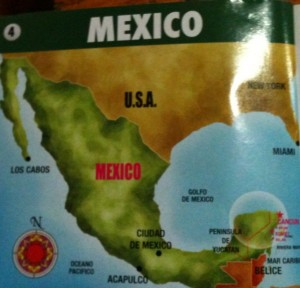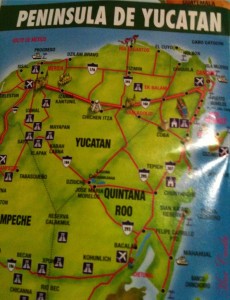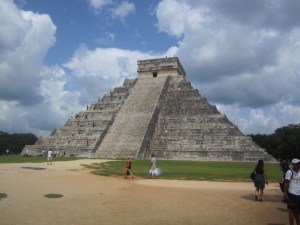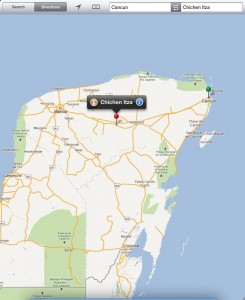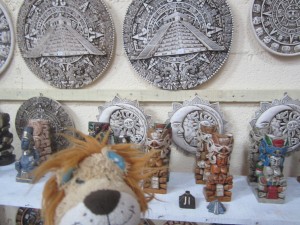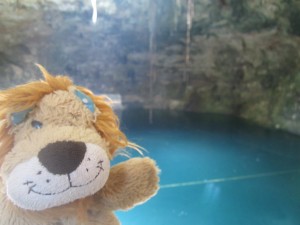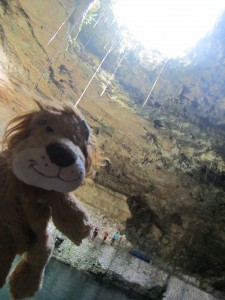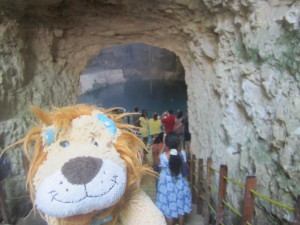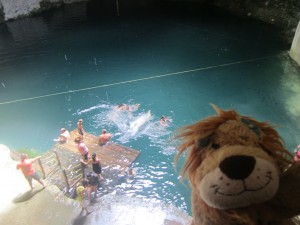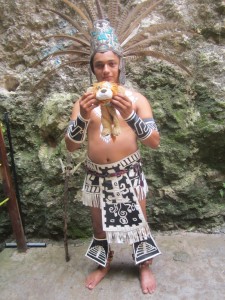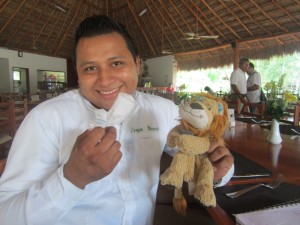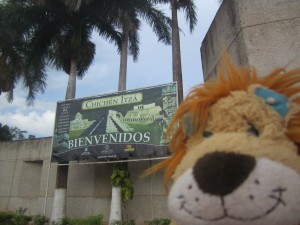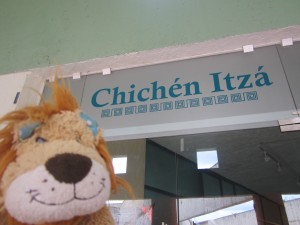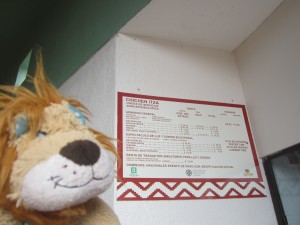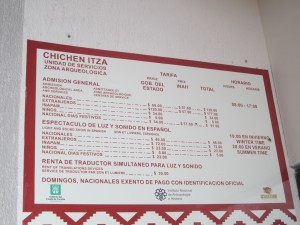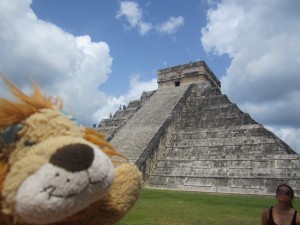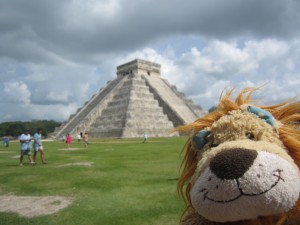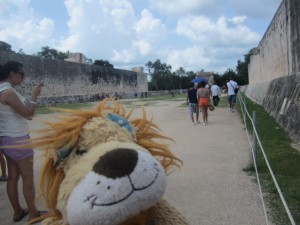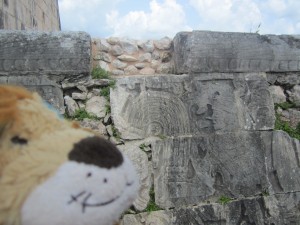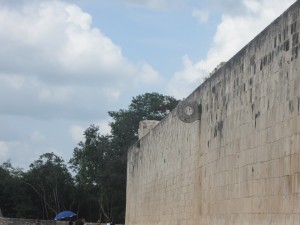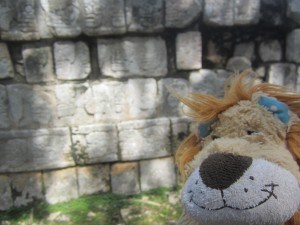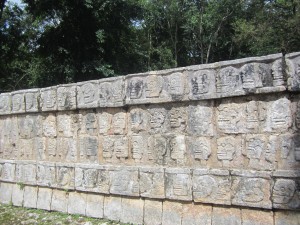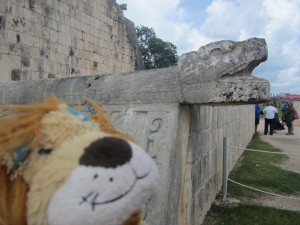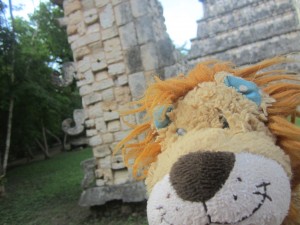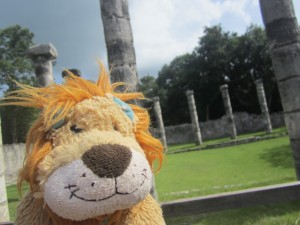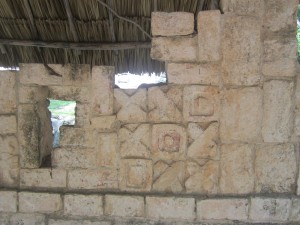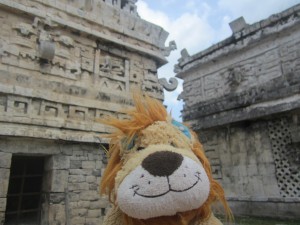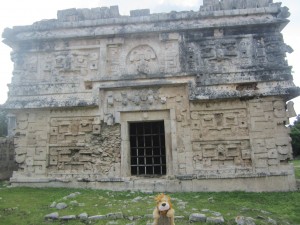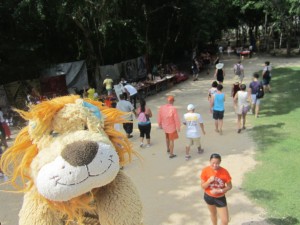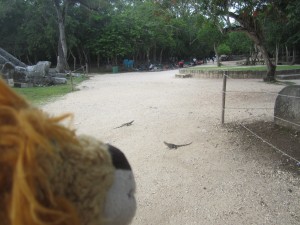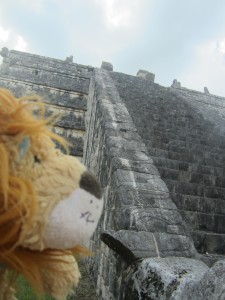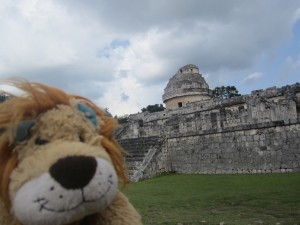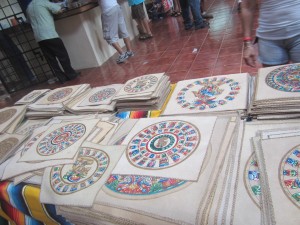It was another early rise for Lewis the Lion as he had another exciting adventure ahead of him. Today was the day he was going to learn something about another great Latin American civilisation: the Mayans of North-East Mexico.
Unlike some of the other indigenous cultures of South America which had been wiped out, the Mayan people still remained with their language and culture, even if nowadays, their great astronomers and mathematicians were no longer around. (Check out Lewis the Lion loves languages page to learn how to say the magic words in Mayan).
He was headed for Chichén Itzá (pronounced “chee-cha nee-sa” or as the tourists liked to call it ‘Chicken and Pizza!’), one of the most wonderful of the Mayan sites as it drew crowds and crowds of tourists from all over the world. Like the famous Machu Picchu Incan site in Peru that Lewis the Lion had visited a short time ago, Chichén Itzá was also a World Heritage Site and when Lewis the Lion eventually got there, he could understand why.
Many of the tourists visiting the site, like Lewis the Lion, came on coach trips from the popular, Mexican beach resort of Cancun. However, it was a fair distance, about 3 and a half hours in total and so there were various stops along the way, mainly encouraging the tourists to buy their Mexican souvenirs. Lewis the Lion got a little bit bored and exasperated by this, especially when they snaked him around every aisle of a souvenir shop. Yawn! Yawn!
However, a couple of stops were worth it, notably a visit to a naturally forming cenote or sink hole.
This looked like a beautiful, turquoise, caved-lake to Lewis the Lion and he discovered that the Yucatán Peninsula had lots of them as it is a limestone plain so there are no rivers or streams.
There were steps down to this naturally formed swimming pool and some people were taking a dip.
On the way down to see it, Lewis the Lion met a traditionally dressed Mayan, who like the Aztecs had a feathered head-dress.
It was here that Lewis the Lion met another Luis (as the Spanish say it) who taught him some of the magic words in Mayan. (Go to the Lewis Loves Languages page to find out more).
Their lunch time stop involved yet more tourist shops, (boring!) but they were also entertained by some traditional dancers. You can click here to see what Lewis the Lion saw.
Eventually, the coach load arrived in Chichén Itzá where they got a very hot and humid welcome, along with more traders selling all sorts of goods, like sun hats, water and crafts linked to this famous site.
Looking at the entrance costs, can you work out how much it would cost you and your family to visit Chichén Itzá? Use Lewis the Lion’s blog on the Mexican currency to convert it into pounds and pence.
The tourists waited to receive their entrance tickets, before the group was split in two, with a Spanish speaking guide and English speaking guide respectively. This time Lewis the Lion and Helen decided to go with the English speaking guide because in their mother tongue they wanted to be able to learn as much as they could about this fascinating civilization that was formed as early as 1500 BC.
As Lewis the Lion wandered into the main site of Chichén Itzá, along a rainforest track, he gasped in amazement as he saw the huge central pyramid, also known as the Temple of Kukulkan, the Feathered Serpent God. (The Toltecs and Aztecs called this same god, Quetzacoatl). Like the Ancient Egyptians, the Mayans were well-known for their pyramids. This particular pyramid is the largest in Chichén Itzá and was used for religious ceremonies and for observing the stars. (Lewis the Lion learnt that the Spanish named it ‘El Castillo’ meaning ‘the Castle’ which he thought was a bit daft as it didn’t look anything like a castle!). This giant pyramid was built between the 11th and 13th centuries right on top of the foundations of other temples. However, Lewis the Lion discovered that not only was it impressive in size but also because it had been very cleverly designed for a few reasons.
The first reason was that it was built to reflect key points in the Mayan calendar as it was aligned to mark the spots of the solstices and equinoxes. Each face of the four-sided structure has a stairway with ninety-one steps, which together with the shared step of the platform at the top, add up to 365, the number of days in a year!
Unbelievably, at the point of the equinoxes, the shadow falls on the pyramid in such a way that it looks like there’s a snake slithering down its steps! ‘How cool is that?!’ Lewis the Lion thought to himself but he was about to witness something ‘cooler’ still (apart from he passing thunder storm)!
The guide got the tourists to clap at one point near the temple. Lewis the Lion was amazed by the what happened next. The acoustics of the building made the clapping echo and the sound produced was identical to the call of the quetzal bird, the revered bird in Mesoamerican culture. This is a very rare bird, with green and yellow plumage and Lewis the Lion remembered that he’d seen the feathers of this bird in Moctezuma, the Aztec leader’s head-dress. Quite incredible! Unfortunately, he only caught a little bit of this on a video, but here it is. Clapping at the Temple in Chichen Itza.
Next Lewis the Lion’s tour group was led to another location close to the pyramid which fascinated him. It was the largest ball court in Mayan civilization and luckily for him, he’d made another friend on his journey, Sariah, who helped to look after him.
This Great Ball Court is larger than a football pitch and the game played here was ritualistic.
Once upon a time people believed that the losing team were sacrificed but historians now believe that it was the other way around and it was in fact the winning team.
The two teams were the Jaguars and the Eagles and it was a great honour to compete in one of these games which would last for days on end. The idea was to shoot a ball through a stone hoop high up on a wall.
This may sound easy but the competitors could only do it with their elbows, hips or knees, which is why the game often took so long! Often games were played during times of drought and the winners were sacrificed to the Rain God. However, before the Spanish had arrived, the site was already abandoned as people began to realise the futility of such a competition.
At the bottom of the ball court, Lewis the Lion discovered a wall with carved skulls and he wondered if they represented members of those winning teams?
Another gruesome discovery that Lewis the Lion made about the Mayans was that there was a sacred cenote at Chichen Itzá too were often children were drugged with alcohol and drowned in offering to the rain god, Chac! ‘Thank goodness that doesn’t happen nowadays!’ thought Lewis the Lion.
As Lewis the Lion’s visit to Chichén Itza continued, he learnt that this site was built up during different stages in history and was in fact a Mayan and Toltec mix. What really impressed him though was the detail and intricacy of the stone work as you can see in these next few pictures.
Lewis the Lion strolled through this impressive site on his own after the main guided tour had ended. Along the tree lined walk-ways were many tradesmen selling their souvenirs.
However, they weren’t the only residents here in Chichen Itzá as it appeared that there were many reptiles that had also made their home here.
Lewis the Lion loved seeing them scamper around this magnificent site as if they owned the place!
One of the places that Lewis the Lion was interested in visiting was the Mayan Observatory. The Mayans were renowned for being great astronomers and had their own calendar system based on their celestial observations. In their calendar, there were 18 months in the year with 20 days, plus 5 unlucky days!
To find out more about the Mayans and their special calendar, click here.
What another fascinating day of learning, Lewis the Lion had had. At the end of his visit he felt very tired and ready for a sleep on the coach back to Cancun, along with some of his other new friends he met there!

